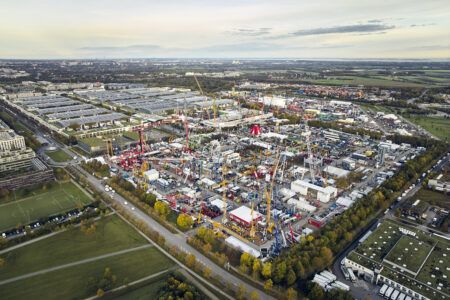California-based Artisan Vehicle Systems has been fitting its battery-powered electric powertrains into the mining vehicles of various OEMs for several years. But it has changed strategy with the release of its new 153 LHD (load haul dump) vehicle. For the first time, Artisan has produced every component of the battery-powered 1.5-yard, 3 metric ton LHD underground mining vehicle and is selling it under its own name.
“We are looking to have a similar business model to the global giant Caterpillar,” says Mike Kasaba, CEO of Artisan. “They sell their diesel engines to OEMs, but also make their own vehicles. Lots of major mining companies have integrated our powertrain into scoops and trucks that were originally made for diesel, but the new Artisan 1.5-yard LHD has been designed from the ground up uniquely for our battery system.”
Artisan launched the LHD in September, and it is already proving popular in an industry slowly waking up to the benefits of battery technology. The company has sold out of the vehicle for the rest of 2016 and is taking orders for the second quarter of 2017. “The interest is part of the mining industry’s move away from diesel technology,” says Kasaba. “At MINExpo, executives from every major mining company told us they know battery power is the future and they have to plan now for the coming transformation from diesel to zero-emission vehicles.”
Death of diesel
The tipping point, when battery-powered vehicles outnumber diesels, has not yet been reached; most underground mining vehicles are still powered by diesel. “We can make it happen quickly, but only if we get the message across about their superior performance and lower costs compared with diesel,” Kasaba says. “If we can do that through publicizing the success stories, then by 2020 every request for proposal will be for a battery-powered vehicle and diesel will be a thing of the past.”
Kasaba says the cost savings from using machines like the Artisan LHD vehicle in place of diesel are huge. A major factor is that using battery-powered equipment reduces the requirements for ventilation shafts to clear fumes. They can cost between US$50m and US$100m each. In most mines, 40% of energy costs go on ventilation and cooling. In ultra-deep mines the figure can reach as high as 90%. Diesel emissions are the major source of fumes and some mines have as many as 150 diesel machines working underground.
“A new mining project is an opportunity to save real money. A project using diesel could require four ventilation shafts, but with batteries, two shafts would be enough,” says Kasaba. “Also, if a company using diesel finds an adjacent ore body, it has to sink additional ventilation shafts. But that’s not necessary with battery power. The company saves on capital expenditure and can reach the adjacent ore much more quickly.”
Improved performance
Battery-powered machines are by no means an inferior alternative. On the contrary, their mechanical performance is far superior to diesel, according to Kasaba. The new Artisan 153 vehicle has 300% of the horsepower of a diesel 1.5-yard LHD equivalent. It loads more quickly, hauls up steep grades faster and is more precise, he says.
“Electric motors are very power dense with high torque and they fit into a very small space,” says Kasaba. “For conventional diesel machines, the OEMs use the smallest engines possible that will get the job done. That’s because the amount of ventilation required is determined by the horsepower. But we can put in a high horsepower and it has no effect on the ventilation. And because the battery-powered vehicles are smaller, they are more maneuverable. They can get in and out of stopes more easily and pull the ore out faster.”
The experience for the underground workers, too, is far more agreeable. They don’t have to put up with hot diesel equipment belching out fumes and their voices are not drowned out by noise. “Diesel machines can be so loud you have to scream to be heard, but all you can hear with battery machines is the hydraulic system running as the motors are essentially silent,” he says.
The improvements in performance have been made possible by recent advances in lithium battery technology. Artisan tested all possible battery technologies over the years and, in the end, settled on lithium for hard-rock environments. In soft-rock environments, such as coal, salt and potash, lead-acid batteries work fine, but hard rock, including copper-, gold-, silver- and lead-bearing ores, demands smaller and more powerful machines that are best powered by lithium batteries. The vehicles can be charged in an hour for at least four hours’ running time, or the batteries can be swapped over in around 10 minutes.
New factory
Artisan has built a 60,000ft2 (5,574m2) battery development center and production facility in Camarillo, California, to carry out research into every aspect of the powertrain, including the battery, electric motor, vehicle controls, power electronics and high-powered chargers. The facility will also ramp up production tenfold to cope with anticipated demand. “California is the home base for Tesla and other manufacturers of electric vehicles,
so it’s a huge intellectual center for what we’re trying to achieve,” says Kasaba.
Artisan offers remote technical assistance to any clients who
own vehicles equipped with its powertrains, including those sold under the name of a different OEM. Artisan’s California-based technicians are connected to the vehicles through web-based technologies. “They can communicate with local technicians in remote mining areas. It’s as if we are sitting right beside them even though we could be thousands of miles away,” says Kasaba.
Whenever a vehicle is connected to a battery charger, Artisan’s technicians receive information about every action it has performed. Faults show up on screen in California. “We can then talk live through our system to the technician and try to diagnose any problems. And we can remotely upgrade our software,” says Kasaba.
Golden partnerships
Artisan has been working to develop its powertrain technologies in partnership with OEMs since 2010. One of the most productive partnerships has been with Kirkland Lake Gold (KLG), which relies heavily on Artisan’s equipment for its gold mines in Ontario, Canada. At Kirkland Lake Gold’s Macassa Mine, for example, Artisan’s electric powertrains drive 14 underground machines, including 3.5-yard scoops and 20 metric ton haul trucks. The local company, RDH Mining Equipment, of Alban, in Ontario, supplied the vehicles, and incorporated the Artisan powertrain technology. Kasaba says that KLG’s stock has quadrupled since 2013 and it has acquired two additional mining companies. He believes the cost savings and superior performance from battery power have contributed to that success.
“RDH Mining Equipment is a small company and, while we’re very happy with the work we did with them, we also wanted to work with larger engineering companies, so we partnered with Atlas Copco, a giant with access to huge engineering departments. We knew we could rely on their integrations to produce superior performance,” he says.
One of the fruits of the partnership with Atlas Copco is the Scooptran ST7 Battery vehicle, which was launched in May. Artisan provided the battery technology. Atlas Copco says it produced the vehicle to provide the market with alternatives to the more common tethered electric vehicles. Like Kasaba, Atlas Copco believes the trend for deeper mines will make electric vehicles necessary to reduce high ventilation costs.
Beating the battery lag
Considering the potential cost savings, superior performance, and environmental benefits, the mining industry’s sluggish embrace of battery technology comes as a surprise to many people. But Kasaba says there are logical reasons for the industry’s conservatism.
“To understand why, you have to look at the planning and execution process for major mining companies,” he says. “They invest hundreds of millions of dollars and the payback is often not for several years, so they have to make their investors feel safe. How do they do that? By doing things they know will work for sure. Mining lags behind in accepting new technology because companies don’t want investors to feel they are taking risks and, therefore, feel less safe.”
But Kasaba says that if Artisan can demonstrate to nervous investors, that the up-front costs of battery-powered vehicles are roughly equivalent to diesel ones, the battle can be won. “If we look at the cost of the machine without the battery pack there’s a slight premium for battery but it’s not outrageous. If we look at the cost of a battery pack over its four-year life before it has to be remanufactured and compare that to the cost of diesel fuel, it’s also comparable.
“The other benefits of batteries – lower emissions, lower ventilation costs, cooler and quieter motors, lower maintenance costs, and superior productivity – go direct to the bottom line,” he says.





